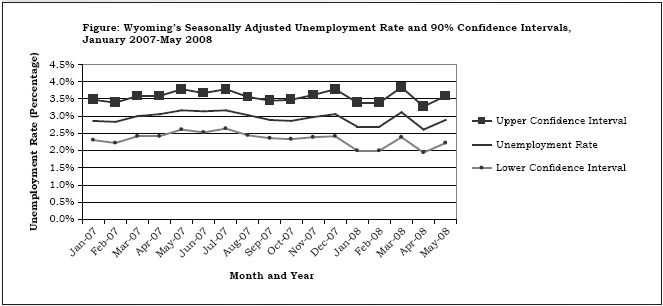Ask an Economist
QWyoming’s seasonally adjusted unemployment rate fell from 3.1% in March 2008 to 2.6% in April 2008, but the article on page 20 of June 2008 Wyoming Labor Force Trends (Bullard) says this was not statistically significant. Why is a reduction of 0.5% statistically insignificant?
AAt the state level, the monthly unemployment rate has a fairly large error range associated with it, mostly because it is based on a relatively small sample (approximately 955 households in Wyoming). State unemployment rates are produced by the Local Area Unemployment Statistics (LAUS) model. LAUS combines data from the Current Population Survey (CPS, or household survey) with Wyoming Unemployment Insurance claims data and Current Employment Statistics program data. The March estimate of 3.1% has a 90% confidence interval of 2.4% to 3.8%. April’s estimate of 2.6% falls within that range, which means it is not a statistically significant change. The Figure shows the unemployment rate and the 90% confidence interval around it from January 2007 to May 2008.
Much of the data that Research & Planning publish come from sample-based surveys. A random sample (955 households, for example) is drawn from the universe (all households in the state). Based on the data provided by the sample, we make an estimate of some characteristic of the universe (for example, the unemployment rate). Because it is based on a sample, the estimate will often differ from the true percentage that would be obtained by collecting data from all households in the state. The confidence interval is a way of showing how accurate the estimate is. When we publish a 90% confidence interval, it means that in 9 out of 10 cases the confidence interval would contain the true unemployment rate.
In order to make more precise estimates of unemployment, the sample size of the CPS would have to be increased. Increasing the sample size would cost money and would also create more respondent burden as more households would be contacted by the U.S. Census Bureau to participate in this monthly survey.
Q
What is the establishment survey?
AThe establishment survey (also known as Current Employment Statistics, or CES) is a monthly survey of employers. We call it the establishment survey to distinguish it from the household survey (the Current Population Survey, or CPS) from which the unemployment rate is derived. Each month a sample of firms reports the number of employees on their payrolls and those employees’ hours and earnings. The reference period is the payroll period including the 12th day of the month. We use the firms’ reports to make estimates of employment by place of work for each sector (mining, construction, manufacturing, etc.). These employment estimates are found in each issue of Wyoming Labor Force Trends under the heading “Wyoming Nonagricultural Wage and Salary Employment.”
We also produce estimates of hours and earnings for production workers in the manufacturing sector (see “Economic Indicators”). We are currently developing average hours and earnings series for all employees for a number of sectors (natural resources & mining; construction; trade, transportation, warehousing, & utilities; professional & business services; educational & health services; leisure & hospitality; and other services). These all-employee hours and earnings data series are considered experimental and are currently published on the U.S. Bureau of Labor Statistics website at http://stats.bls.gov/sae/experimental/sae56.htm.
The data that employers report each month are used to make estimates for certain metropolitan areas, each state, and the U.S. as a whole. For example, when an employer in Cheyenne reports employment, payroll, and hours, those data are used in estimates for Laramie County, Wyoming, and the U.S.
To submit a question to “Ask an Economist,” please e-mail April Szuch at aszuch@state.wy.us.
ReferencesBullard, D. (2008, June). Wyoming unemployment falls to 2.6% in April 2008. Wyoming Labor Force Trends, 45(6). Retrieved August 6, 2008, from http://doe.state.wy.us/LMI/0608/a5.htm
Return to text

Last modified on
by April Szuch.
